Rotate mobile devices for easier reading.
Not What You Expected
You start the day early and after a fifteen minute briefing from the operator you are about to fulfill a lifelong dream of not only seeing orcas in the wild, but actually swimming with them…
A few months ago you discovered videos and photos on Instagram showing huge pods of orcas swimming with one or two snorkelers in the wild and it blew you away.
Set against the picturesque fjords of Norway as a backdrop, it seemed like a dream, but after a brief search on Google for ‘swim with orcas in Norway‘ you quickly found a company offering visitors the chance to do this.
In just a few hours it will be you swimming with orcas and you are beyond excited…

Fast-forward – Seven hours later and after a long day at sea you are almost back in the harbour feeling disappointed. You also feel incredibly guilty and too ashamed to even think about sharing the clip you managed to record on your GoPro showing orcas swimming within just a few meters from you.
Somehow the other ten strangers on the boat are all laughing and joking and none of them seem to have shared your version of what happened. This upsets you even more and you have not said a word the whole way back and all you want is to get off the boat.
How is what you just witnessed possible?
How is this even being allowed to happen?
How are more people not speaking out against this?
The Reality
What you (and hundreds of other guests each season) experienced, was shockingly different from the expectation you had.
Sitting in an open boat with many other guests (some visibly not in the greatest shape) wearing warm survival suits over drysuits, you drove a few hours through choppy seas to reach the place where orcas had been seen this season. Even on the way you could not miss the other five boats which overtook you with groups that looked just like yours…
You thought – ‘It must be a spread out area with many orcas…’
You have a seat close to the skipper and as you travel you keep seeing her checking her phone, studying some sort of marine traffic map. Eventually she sees you looking at her and excitedly says;
“We know where the orcas are!”
You stare at her with a confused smile and pointing at the map on her phone she says;
“Do you see all these purple dots? They are boats and they are all in the same spot. The orcas will be there!”
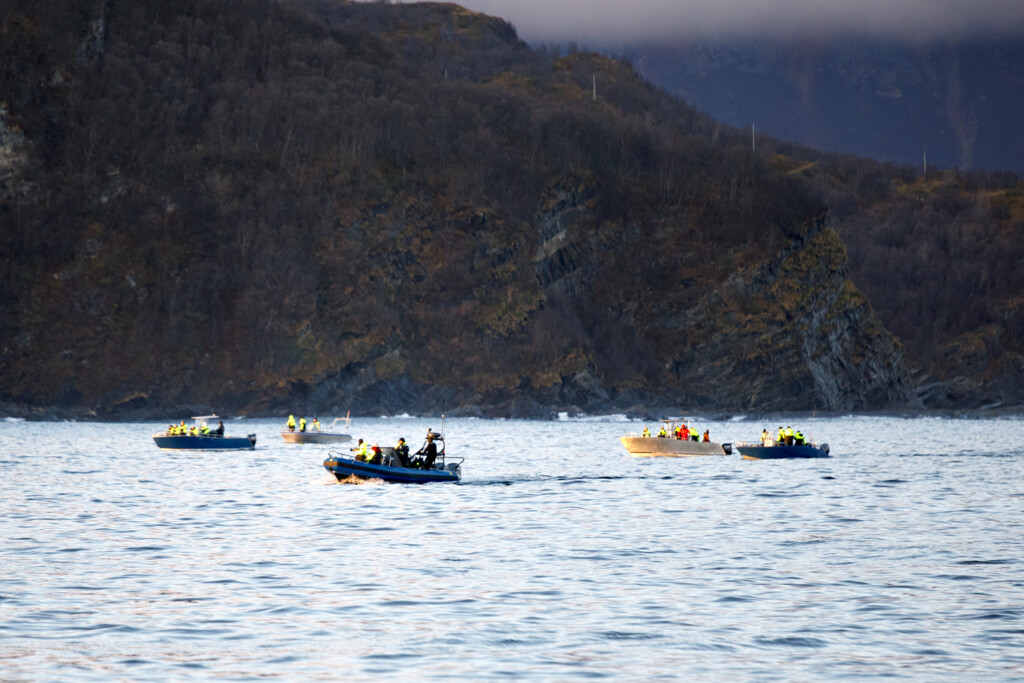
As you come around the corner into fjord, you see it.
A mix of roughly 18 to 20 boats, some like yours, one or two yachts, two large ferry looking vessels and even a few smaller powerboats. In the middle of all of this you finally manage to make out some black fins cutting through the water. You are incredibly excited but also very confused and…shocked.
It takes while to reach them until eventually your boat pulls into this ‘traffic’, as your skipper now tries to get your group to see the orcas. Everyone is excited and trying to get a video or photo, but at the same time several other boats are pushing to get ahead of yours, while angry gestures are exchanged between the drivers.

In no time you and ten other boats are almost on top of the orcas (who are moving fast) as your skipper calls out;
“Wow they are letting us get so close”
Somehow your gut tells you that is not really what is happening and you want to say something (is this is not harassment?), but then your skipper instructs everyone to get their mask, snorkel and fins ready and to prepare to jump in the water…
The idea of swimming with orcas already made you nervous, but jumping into the water with all these boats moving all around you is terrifying. Somehow no one else seems worried, so you just go with it.
Chaos ensues as everyone gets ready and your earlier suspicion that some of the other guests have never been in a dry suit (or any wetsuit) is confirmed. You are also still uneasy about the fact that there is no in-water guide, but the operator assured you it was unnecessary.
Eventually everyone is ready and your skipper pushes ahead of the moving orcas and tells you to get ready. When your boat is about 30 meters ahead of the orcas, she cuts the engines and yells at everyone to jump in.
Flailing arms and legs with several loud splashes and less than 5 seconds pass before you see it – about seven orcas just a few meters below you moving fast, one or two on their sides looking up, the rest moving a bit deeper. You lift your head as several other boats pass on either side of your group. You can see people on them gesturing angrily and shaking their heads. You turn around to see another boat had dropped their group just twenty meters from your group using the same strategy.
After some confusion (your group getting mixed with the other group in the water), eventually your people manage to get back on the boat and you can here some people excitedly saying things like;
“I can’t believe it, they stopped and looked at me!”,
“Did you see how they turned to check us out?”
“I could hear them getting excited and talking to us”
You are in awe of what you saw but somehow your perception of what just happened was not as ‘intimate’ as what these people are describing. Are they just saying things they want to believe? To you it looked a bit like the orcas were just trying to avoid your group…
With everyone back onboard, the boat starts racing forward again to catch up with the orcas and your operator yells;
“Get ready, we go again!”
And for the next hour this scene repeats. Boats all pushing each other, some giving up, many others arriving until eventually its impossible to keep track. Each ‘drop’ the orcas seem to stay deeper and come up less frequently. Somehow after every drop your driver says things like “the orcas are getting used to us” and “these other boats are really behaving badly”.
After the third drop you don’t even try and get in the water anymore and just say you are tired and want to enjoy it from the surface.
In reality you just want to get off the boat and out of this nightmare situation.
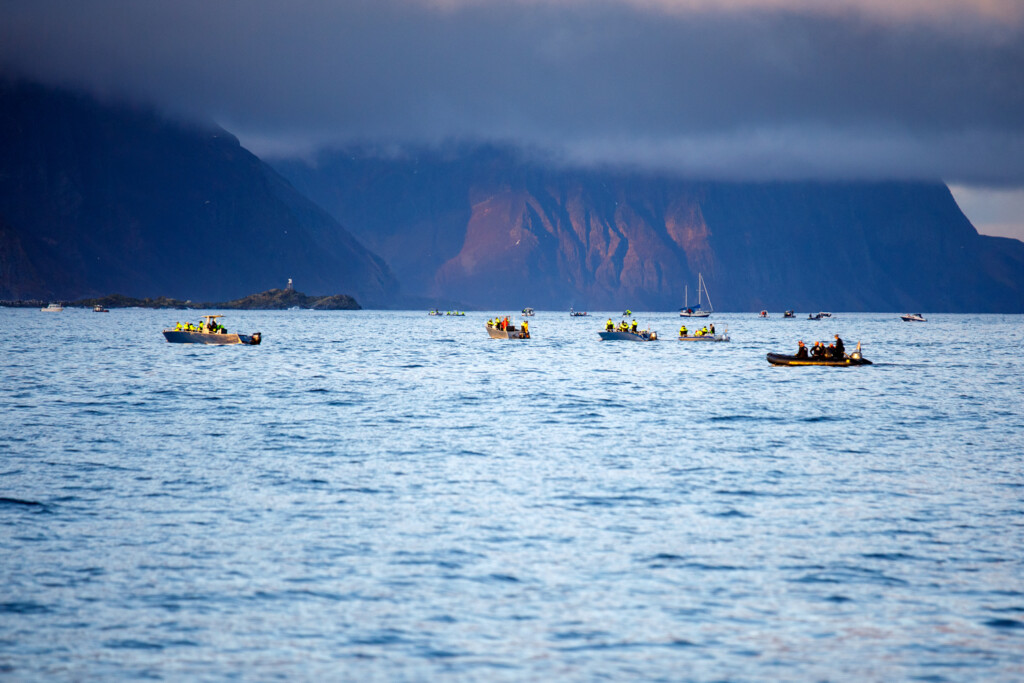
How Is This Happening?
The situation in Norway is a complex one and it has deteriorated quickly over the last few years. If trying to answer this question, the most basic answer would be;
There are too many boats on the water.
The question then becomes – why? And here is where it gets murky, although at the core of the problem some basic issues exist;
1 - Almost zero regulations for cetacean tourism in Norway
For decades it has been possible to visit Norway in order to join trips where you could see primarily sperm whales, orcas, and humpback whales. Until 2019 there had been no real regulations controlling the practice of whale watching in Norway and only some of the original operators were at the very least following guidelines set forth by the industry.
As the popularity of these trips exploded, so did the amount of traffic (informal operators, foreign ships, documentary crews etc). Already since 2018 the situation deteriorated dramatically with several foreign and ‘informal’ operators, as well as quite a few locally based operations having pushed the boundaries too far. The most notable of these events took place during the 2019/2020 season. This included (but was not limited to):
-
- close proximity to active fishing operations, resulting in unsafe situations and in some cases requiring the intervention by the coastguard.
-
- aggressive chasing / attempts at herding cetaceans,
-
- overcrowding
-
- no formal qualifications or experience
-
- unsafe and unethical practices
‘Cowboy’ style operating also included people driving tiny, unassisted tenders out to sea (not designed for open water) and diving off the back of sport and fishing boats. For example, the people in the photo below are standing right above the propeller on a small platform not intended for this purpose.
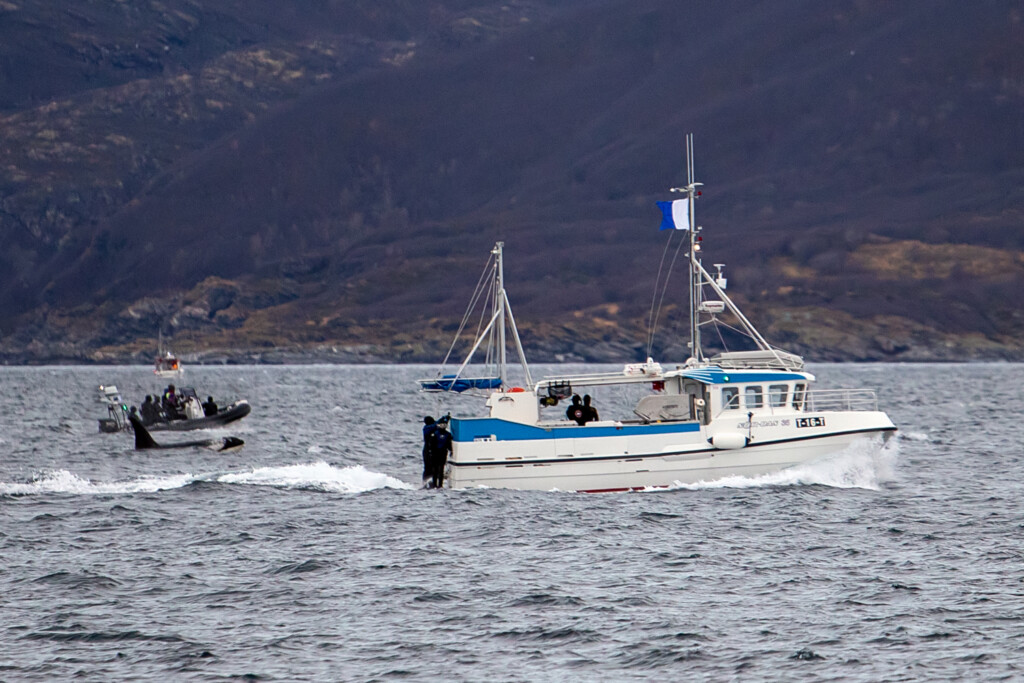
These incidents drew national interest and made the local news and continue to do so. Several articles since then reference numerous incidents and issues related to the ‘whale safari’ season (examples which can be read with google translate enabled);
Despite all of this, the authorities took no real action and only when whale watching interfered with the fisheries (Norway’s second largest source of income) did they take it seriously.
The first strict ‘knee jerk’ regulations were implemented after a shocking incident involving a semi well known Hawaii-based ‘Underwater filmmaker’, a British explorer /adventurer (who is the CEO of an adventures company) and a couple of their very wealthy clients. These first time visitors flew into the fjord on a private helicopter and chartered a local and his boat. They then then proceeded to try and handfeed herring to wild orcas from a bucket and ultimately went snorkeling under the pump of a working trawler at night.
Unfortunately for them, the authorities were on that trawler and filmed it all (eventually chasing them away).
Almost over night new regulations were imposed banning any whale watching boat from being near active fishing. Since then boats are prohibited from being closer than 370 meters from a fishing vessel, while people swimming, paddling or diving must be at least 750 meters away from fishing vessels.
This has greatly complicated whale watching as fishing trawlers fill the fjords where the orcas and humpback whales are, who in turn follow the fishing trawlers.
Beyond this, little to no regulations existed and despite several crisis meetings in the seasons since then, not much has changed. It is not an exaggeration to say that some of these boats operate in plain sight (sometimes right next to) coastguard ships.
2 - Little to no enforcement of existing maritime and commercial laws
The Kystvakt (Coast Guard) and Fiskeridirektoratet (Directorate of Fisheries) along with the Sjøfartsdirektoratet (Maritime Authority) play a very important role in monitoring the fisheries as well as the conduct of all vessels at sea. During the herring season these government entities are very focused on the fleets of fishing trawlers and boats which arrive from all over Norway and understandably have their hands full.

In the last few years their part in regulating the whale watching industry has also become more important (and needed), although it is extremely rare to see them take action when whale watching is involved. This typically only happens for short bursts after public outcry when incidents like those referenced reach the local news.
This means that unsurprisingly many whale watching boats are at sea lacking the correct maritime / commercial licenses, equipment or in some cases safety equipment and they simply go unchecked.
3 - An increase in high turnover operators
In 2024 just one local operator is expected to have as many as 8 to 10 boats carrying 10 guests each, all operating simultaneously in the area where the ‘orca season’ plays out. This is just a drop in the bucket of all the operators that will be on the water.
Similar to a goldrush, many operators hope to cash in on this new popular tourist activity and many operators try to capitalise by having;
-
- quick turnovers (day trips / short stay)
. - bigger groups / more boats
. - no requirements
. - low cost logistics
- quick turnovers (day trips / short stay)
This means dozens of smaller fast boat operators on the water which results in situation like those in the opening of this article.
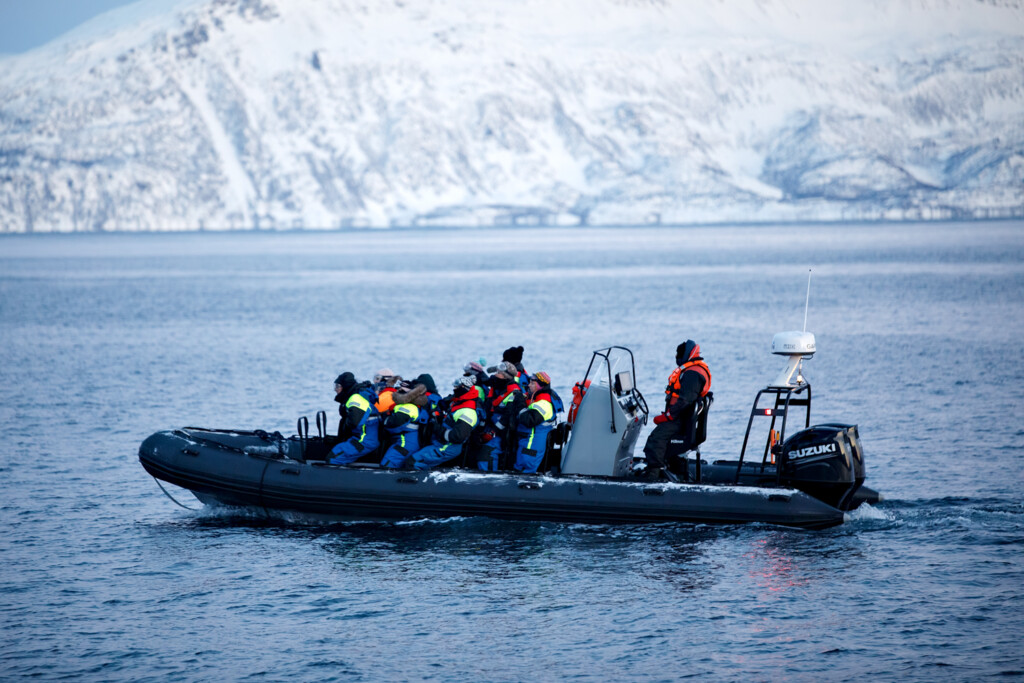
For the most part day operators:
- have a matter of hours to ensure clients get the experience they pay for. This unfortunately places a lot of stress on the operator to deliver and results in animals being chased, harassed and very often overwhelmed by boat traffic. It is not unusual to see as many as 20 boats on a single pod of 5 to 12 orcas. Situations like this can last hours (for as long as there is daylight), all boats chasing and trying to get ‘the best position or view’ which directly influences the normal behaviour of the animals.
. - have poor or no preparation briefings, no checks and no prerequisites for clients to be able to enter the water, creating not only unsafe situations for the people in the water but also high stress and unsafe conditions for the animals.
. - often takes as many as 12 people per trip, some of whom do not have an experienced or qualified in-water guide or supervisor.
. - operate illegally. In recent years far too many operators (day, long-term, topside and in-water) taking guests to sea without the correct certifications, equipment or training required by Norwegian law in order to operate any form of commercial maritime activity.
Given the potentially harsh conditions (extreme cold, extended times at sea, physical excursion), it should also be crucial to have clients meet a basic health and physical standard. But even this is not required by most operators, as not setting a ‘limiting’ standard ensures a wider client pool.
As an example of the potential risk due to the type of activity and the environmental factors – one health related fatality already occurred in 2019 when a 45 year old Swiss client suffered a heart attack while in the water.
4 - Visitors budget supersedes their ethical considerations.
For most visitors this experience falls into the category of adventure travel, but even for the more eco-conscious visitors the cost plays a decisive role on HOW they take part. The larger the group and the more ‘barebones’ it is, the cheaper it will be.
This means many unethical operators who tend to dump their prices to compete (often possible due to not paying tax in Norway) remain in business because the demand is there. Even for someone who knows they might be joining an unethical trip, the ability to afford it makes them turn a blind eye to the reality of what they are supporting. Sadly for the average visitor it is nothing more than ignorance – find the cheapest option and book it. Sometimes it really is as simple as;
‘see a video, realise it is possible to swim with orcas, find a cheap option, book it’.
There is an ever-growing list of similar situations throughout the world where social media has sold the accessibility of swimming with large marine life without any context (what is the impact? how can you do this ethically?). Even for someone who should know better, the fact that so many other people do it unethically, somehow justifies their decision to follow the herd (what difference will my one visit make?).
Like the dolphins in Hawaii, or the Whale Sharks in Oslob, swimming with orcas in Norway has become a major draw for tourism at the expense of the animals. Many of the problems listed here are only possible due to the support of paying clients to operators who should not be active.
5 - Lack of research by potential visitors
For anyone who is even remotely concerned about the darker untechnical side of the orca expeditions in Norway, the information is easy to find.
It is 100% possible to find an ethical, legal operator to experience this event in a more responsible way.
Given all the coverage and past visitors, even a little online research will have revealed many of the incidents shown in this article. A similar article warning of this situation was already published in 2019 and widely shared but long since forgotten and things have gotten worse.
Sadly the majority of visitors prefer not to do any research and would quite deliberately remain oblivious to what is going on. Even after witnessing it, most people only share the sugarcoated version of their experience which in turn draws even more visitors.
6 - Culture of 'conflict evasion'
A lot of the issues listed here continue to exist because Norwegian authorities (and locals) do not like to ruffle feathers, which results in no real long-term action being taken.
A perfect example of this is the seasonal ‘outrage’ which we have been seeing every year for nearly 5 years.
Each season, everything which is outlined here (and more) becomes worse and operators and locals see it and a handful of them demand action. More recently the situation has degraded to the point where local businesses, operators and their employees are losing income or jobs (refer to this article).
Every season, after a few incident there are ‘crisis’ meetings which are attended by all the operators (the good and bad), the NHO, conservation efforts, local municipalities, police and all the government entities mentioned above.
Everyone makes calls for change and every season the results are the same;
- The local news runs a few articles similar to the links above
. - the relevant authorities make a token show of force which usually lasts about week or two, before they shift their focus back to the fishing activities.
. - operators point fingers at each other in closed groups (Facebook etc), but continue to run their trips the same way as before.
. - By February the season finishes after which everyone leaves / moves onto other seasonal work and the whole situation is forgotten.
When the next season starts in October everything repeats.
How could the Norwegian government fix this?
The first thing to understand is that setting regulations for the wellbeing of cetaceans (in support of a whale watching industry) is a can of worms Norway does not want to open.
Why? Partly because Norway is one of the last remaining countries in the world which still allows the hunt of whales (primarily Minke). It is a big discussion, but it comes down to – how can a country issue regulations for the welfare of cetaceans while at the same time issuing quotas for them to be hunted?
So what is the solution?
Considering that this unique natural event happens along the coastline of Norway, potential regulations could focus on something similar to what other countries have been doing for decades. Just one example being both whale watching and shark diving operators in South Africa.
Just a handful of suggestions would include;
-
- Allowing only legally registered operators / companies
. - Tax compliance
. - Potential license system for whale watching activities
. - Setting limits on operators for group sizes / number of boats.
- Allowing only legally registered operators / companies
Even though these points all focus on fair financial trade and asset / people management, it will directly benefit the animals as well by controlling who is on the water. Sadly even this does not solve all the problems but will surely be a start.
Another potential change which could make a difference is if the Norwegian authorities take a hard line on existing laws. By simply focusing on maritime and commercial laws (not even considering animal welfare) and setting up a regular check system for boats, seasonal traffic will already reduce.
As operators we see near daily infractions of the existing laws (boats being right next to active fishing trawlers, boats completely ignoring the significance of an alpha flag and more).
Right now these are all just talking points which seem to go nowhere, but within these suggestions lies some possible solutions.
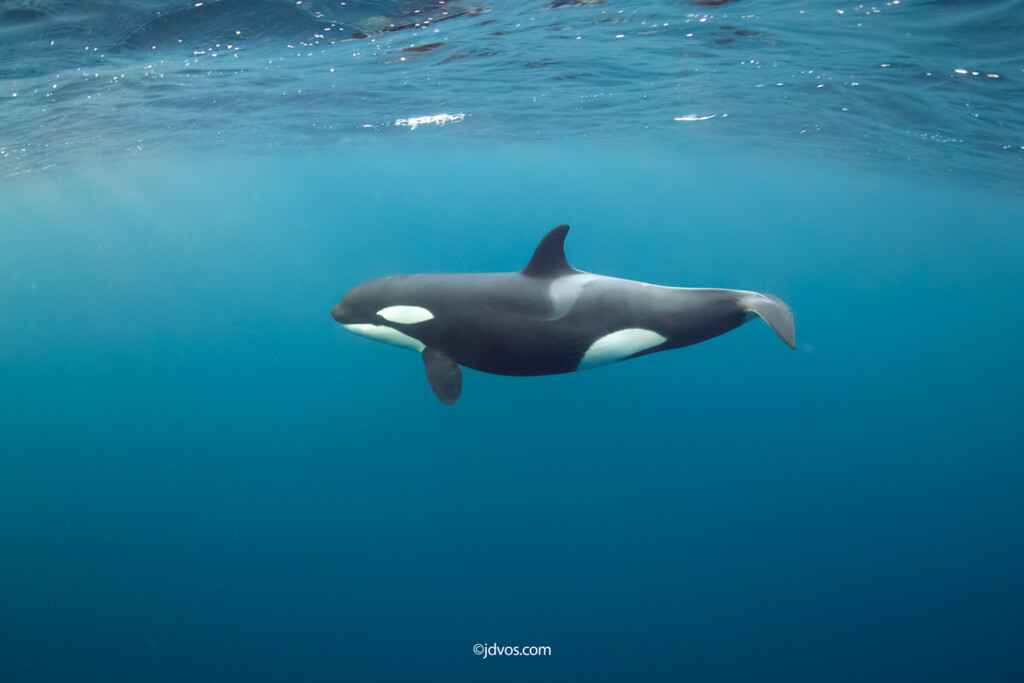
How Can You Make a Difference?
As a visitor, the impact your decisions make are huge. Ranging from who you book with to what happens once you are on the boat – what you decide to do can make a significant difference to help stop the current trend. This next section will cover some of these decisions and outline some basics if you were to join.
Why do you want to go?
It all starts here and it is a simple question. What is your motivation for wanting to see orcas or humpback whales in Northern Norway (or wildlife anywhere) ?
Are you passionate about any of these animals? Do you have a love for nature and the outdoors as a whole? Maybe you are a serious, or even amateur wildlife photographer who simply wants to capture their beauty in such a wild setting?
These are the kind of people who deserves to have the chance to experience these animals in the wild on the animals terms and who surely has the moral and ethical sensibility to recognize unethical and unsafe situations.
If you have little interest in cetaceans and your main goal is to the next viral reel for Instagram or to film a videoblog about how daring you are to swim with orcas, then stay home or go do something else where hopefully you are not contributing to a bigger problem.
Choose the right operator
As incredible as it might seem, the first operators you might find if you Google ‘swim with orcas in Norway‘ are not necessarily the best ones and in many cases they are not very ethical or legal.
Some questions which you should ask or find the answers to include:
- Is this a registered operation or business in Norway? If not, you might be in for a nasty surprise when you arrive and new regulations prevent them from ‘operating’. Tax evasion by foreign operators is a hot topic the last two years and indications are foreign operators will soon be subject to stricter laws and checks. If you are asked to pay for your trip to a non Norwegian bank account, it is not Norwegian and you might want to ask some questions.
. - What qualifications and experience do the guides and crew have?
For example – a commercial boat driver in Norway needs a D5L license (exclusive to Norway) to have passengers onboard. Do not assume someone is qualified because they are Norwegian and own a yacht.
. - Is your in-water guide simply claiming to be an ‘expert’ or do they have the relevant experience and professional qualifications/training to deal with emergencies in and out of the water? Be weary of ‘big name’ underwater photographers, filmmakers, social media personalities etc.
. - How much of an educational aspect is there to what the business / operator offers? Is it a meatgrinder style hop on/hop off experience? Maybe avoid…
. - Can they show what REAL contributions they make to the cetaceans they encounter (scientific, conservation etc)? The last few years almost every operator claims to be associated with NGO’s like the Norwegian Orca Survey. Not all of them are and they do this as it ‘sells’.
. - Do they have formal standards on how they operate and can they explain these (relating to ethical and safe practices)?
. - How many people do they take in one boat? This is CRUCIAL and will be discussed below.
. - What requirements do they have for clients? For example – If it is an in-water expedition and the answer is ‘none’, start looking elsewhere.

Do your research
The internet is an incredible tool when it comes to researching potential businesses or products and operators are no exception. How do you find out what really goes on? Simple – ask the clients who have joined them before. This can be as easy as a short Facebook or Instagram message in reply to someone’s photo from their last trip.
Very often we hear of former clients getting messages from strangers asking them some of these simple questions:
- how was the trip and would they recommend the operator?
. - was anything negative about their experience?
. - were they local (have a physical address)?
. - Were the crew experienced and professional?
. - did they feel like the animals were respected?
Do not simply rely on the reviews found on the actual page of the business or operator as these are very easy to falsify .
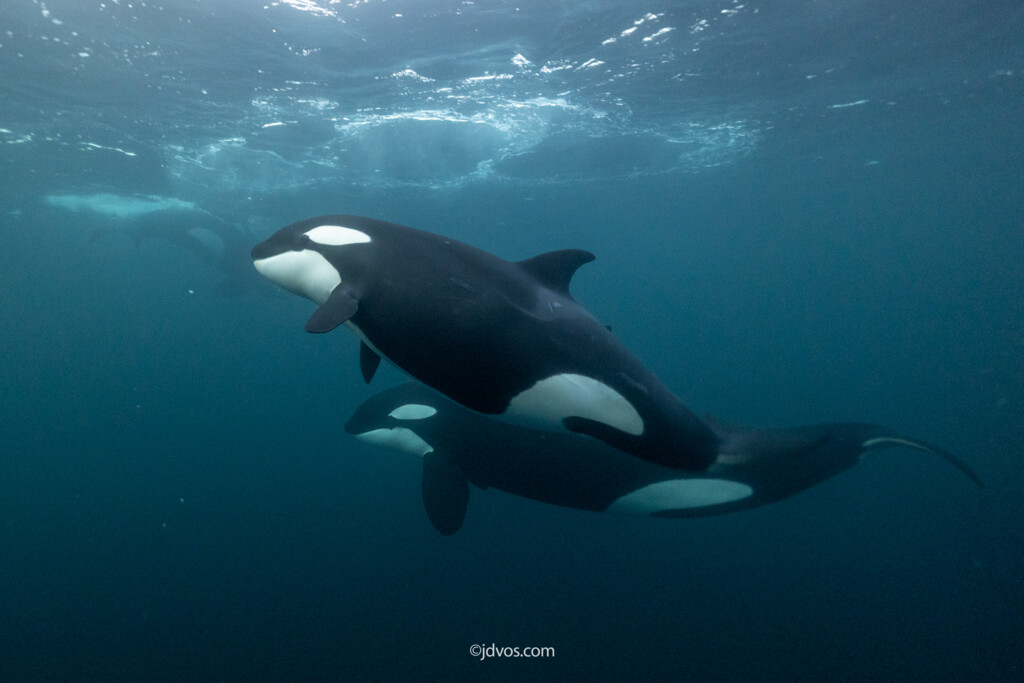
At Sea
Be involved
Once you are with the operator or business you are joining, it is crucial to keep yourself up to speed on what is going on. There is nothing wrong with asking a simple question from time to time (although avoid doing it every 10 minutes!):
“What is the plan / What is happening?“
Whatever the reply is, it is crucial to match the reply to what you see is going on.
For example:
If the answer is “we are heading to a pod of orcas ‘over there’…” – have a look ‘over there’ and try to see what it is the crew are seeing.
- Are there already two or more other vessels in the area where the orcas are?
. - Is there a working fishing trawler where the orcas are?
. - Are the orcas in an area with heavy marine traffic (like the entrance to a harbor)?
‘Yes’ to any one of these questions should trigger instant concern and be followed up by more questions to the crew:
- “Are there not too many boats already around that pod?”
. - “Do we have permission to approach that vessel?”
. - “Is it not unsafe to dive at the harbor entrance?”
In this example, if the answer to any of these questions from the operator is ‘NO’, then it is time to speak up!
By failing to do so and simply shrugging your shoulders and silently objecting, you are directly contributing to the unethical and unsafe practices the whale watching industry and more importantly the animals are facing.
With the right approach you can have unforgettable encounters
Common Sense
When it comes to safety do not always rely on your skipper or crew to tell you what to do / not to do. If something feels or looks ‘risky’ do not do it!
Each season we see potentially fatal mistakes and safety issues and it is only a matter of time before someone else gets hurt. One common example is operators who allow their clients to sit facing outwards while dangling their fins over the water as a boat is underway. Even at low speed this can be fatal if someone dips a fin in the water, gets pulled in by the force of the water and ends up under the propellers.
This happens all over the world and a fairly recent example was in 2023 when a guide was sitting on the back of a boat, legs on the pontoon and leaning against the frame at the back (exactly like the person circled in the photo below in Norway) and on a turn slipped off and ended up under the propellers.
These things can and do happen!
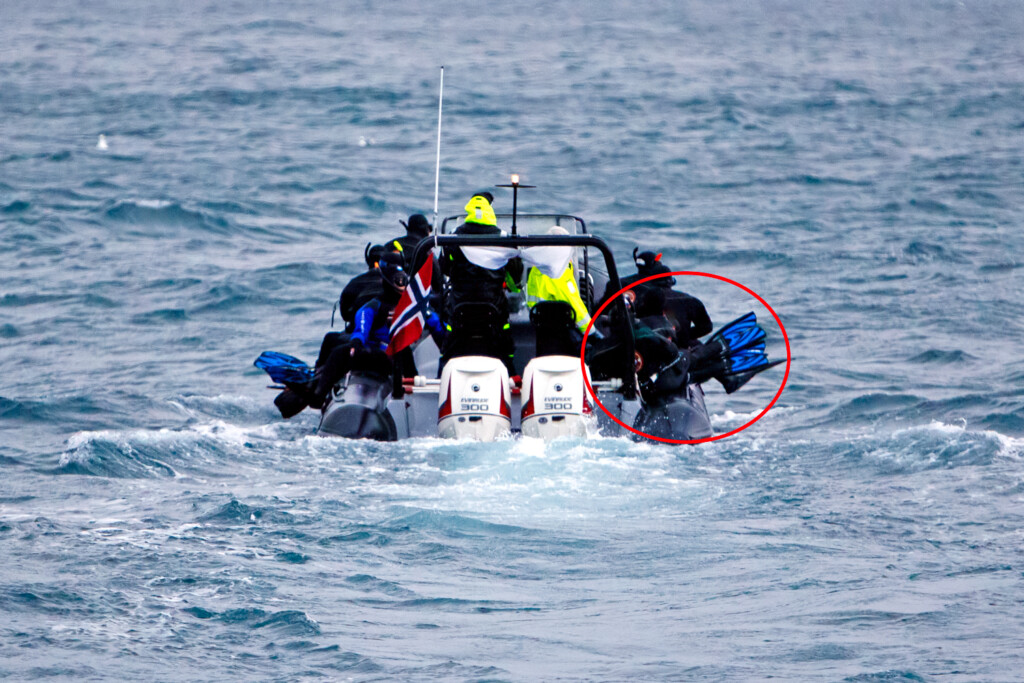
How to speak up
For many, confrontation is something they tend to avoid. The biggest problem is usually feeling like the only person who has to say something. This fear of confrontation easily leads to a lack of action and results in nothing being done about a serious problem.
So what is the best way to speak up against and confront unethical or unsafe behavior?
Do it as a group if possible. If you are uncomfortable saying something alone, go to the other guests and bring them up to speed on what is happening.
Using the previous example – even if you are confident enough to say something, it is still important to loop in the other guests and to make them understand why this is a bad situation. The important step is to actually SAY SOMETHING to the crew or operator. Simply complaining about it amongst yourselves but then still following the crews plan without saying anything to them does not make it OK.
If the crew gets the overwhelming feedback that their clients do not approve of their current plan of action, odds are very good that they will abandon it and change their approach to find something more suitable. This will hopefully also set the trend for the next days…
What to look out for / avoid.
TOPSIDE
Fishing Boats or fishing activity (holding nets close to shore etc):
No whale watching boat (private or operator) has any right or business being near fishing activity. As outlined above, clear regulations now exist and there is no situation where it is permissible (not even if the trawler gives their ‘consent’)
If you see a non-fishing vessel next to any type of active fishing activity it should be reported immediately.
Years ago (before these regulations and all the chaos), a handful of operators were on excellent terms with the fishing community and it was possible to coordinate safe (legal) approaches to working vessels with very strict parameters.
As more boats arrived, new operators would have no idea that this needed to be coordinated and simply pulled up to a working trawler (on the wrong side) and dumped their guests in the water.
Due to these incidents along with the actions of some (like the example earlier), being near working fishing boats is no longer possible as the regulations 100% prohibit this.
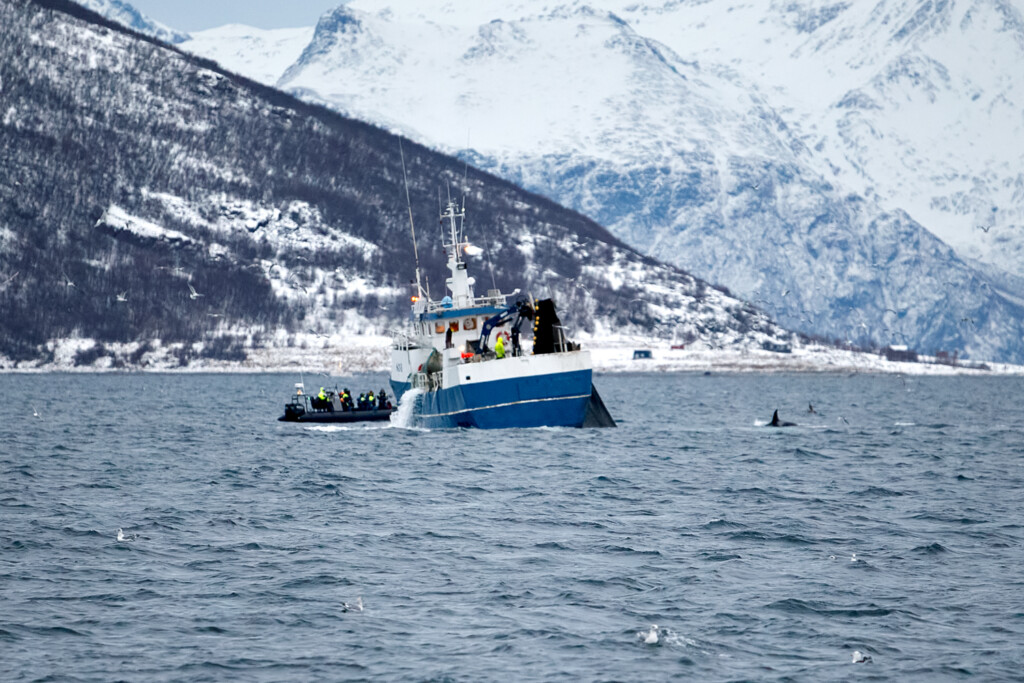
Documentary Film Makers / Photographers – Same Law Applies!
Every season the same situation unfolds – someone with a camera is diving next to a trawler or relentlessly chases the animals for National Geographic, BBC or some other production, magazine or project.
When confronted they will say ‘they have permission’, and 99% of the time this is not the case. You are not permitted to do this – not even if you are ‘famous person X‘, or if your chartered boat captain or guide claims they are a local marine biologist with military diving experience, or past experience with other documentary crews (it has no relevance to the law).
Overcrowding
A good approach to this is if at any point you are near cetaceans and there are more than two other vessels following the same group of animals, it is time to move away. Previous seasons as many as 26 vessels were witnessed chasing one pod of orcas for as many as 4 hours! Do not even try to argue that ‘you were here first’ as sadly the attitude of most operators is to get to the front of the pack.
If at a distance you see maximum two vessels around a group of orcas or humpbacks, you need to hang back at least 300 to 500 meters and wait for your turn to approach. Depending on the situation, each vessel usually has around 30 minutes before having to leave the area. This needs to be kept within reason, so if there is a queue forming, it is also time to leave (the animals need a break as well!).
Racing / Competing
If you find yourself on a RHIB or vessel racing or competing against another vessel who will not stand down, it is time to leave. This behavior will carry on once you reach the cetaceans, which in turn results in a stressful and unsafe situation for them.
Boat traffic
If the cetaceans are in an area with heavy marine traffic such as a harbor entrance or busy channel, you need to move to a safe position and most definitely not attempt to enter the water.
Distance
Follow these guidelines. Anything closer is crossing the line.

It is unacceptable to aggressively chase a pod of orcas at arm’s reach (something we see every season)! If you would like to get ‘close up’ photos invest in a long telephoto lens and keep your distance. Always let the orcas approach you on their terms (it does happen).
Stalking
If the operator you are with uses the tactic of simply following other operators to find activity and then sending you out to the exact same spot where someone else is already having people in the water, you are now part of the problem.
A good example of this is a large foreign operation which sends several large ships to Norway and each of these can carry between 12 and 16 guests (22 with crew) and up to 3 large RHIBs per ship.
What we witnessed and experienced is that a different operator will have found a suitable, relaxed group of animals to interact with, when out of nowhere and without warning one or two RHIBs from these ships show up and drive right onto the same spot / people in the water and deposit anything from between 12 to 22 (or more) of their own clients in the water.
It is complete chaos and the RHIB drivers from these ships have zero regard for what is happening around them.
On several occasions we encountered ships/RHIBs like these and literally had to leave the area as quickly as possible for concern of our own safety as they are often unresponsive to confrontation of their behavior. Needless to say that it is not surprising to see the animals also move out as soon as this happens (see next section).
Again – do your research before booking.
APPROACH / IN-WATER
Group size and ratios
First off – cetaceans tend to avoid groups of people in the water (example above being a good one). The bigger the group of people in the water, the further they stay away. Worst case, they can potentially abandon baitballs or feeding opportunities when there are too many people crowding the area which is unacceptable.
Despite being at the top of the food chain, one of the reasons orcas are so successfully evolved and widespread can be attributed to their cautious behaviour.
If you are on a RHIB or diving boat and there are more than 6 other clients with you, with only one in-water guide present, something is very wrong (both ethically and in terms of safety). Add to this that most likely the majority of these people will have next to zero in-water experience, which is something you will realise very quickly…

To put it into perspective from a safety standpoint:
For a BEGINNER freediving or SCUBA course (using the equivalent of a IDSSC or WRSTC standards-based agency), the instructor to student ratio is 6:1 in open water. This is under controlled conditions with a trained instructor where students are always being supervised and are all at a level to be allowed to enter openwater.
As shocking as it might sound, the majority of the snorkel guides currently running trips in Northern Norway with orcas and humpback whales have no professional training (Instructor level or equivalent) and therefore despite also lacking the professional experience, have zero liability coverage (for which they are not eligible), zero training for in-water emergencies and also no legal basis to work as a ‘guide’.
To expect a person like this to keep an eye on anything from 8 to 12 or more people (this is not an exaggeration) in water which can be 200 to 300 meters deep, in arctic conditions with large marine life and other boat traffic etc around is absurd and incredibly unsafe.
Personally, I have been diving professionally for over a decade (Freediving Instructor Trainer, SCUBA Instructor and Commercial Diver) and have extensive experience diving with large marine life across the world. That being said, I would not feel confident to have more than 5 people in the water with me during an orca expedition in Norway, regardless of their prior experience. Five clients is really the upper limit of what can be considered a safe / manageable group under these conditions and we (Arctic Freediving) have even reduced this ratio down to 1:4 (one professional guide supervising 4 guests).
This does not even take into account the assisted supervision we have at any given time from a quick response RHIB (always within seconds of the people in water) as well as the main diving vessel which is a bit further off.
Read more about why doing a freediving course is a great investment for any expedition
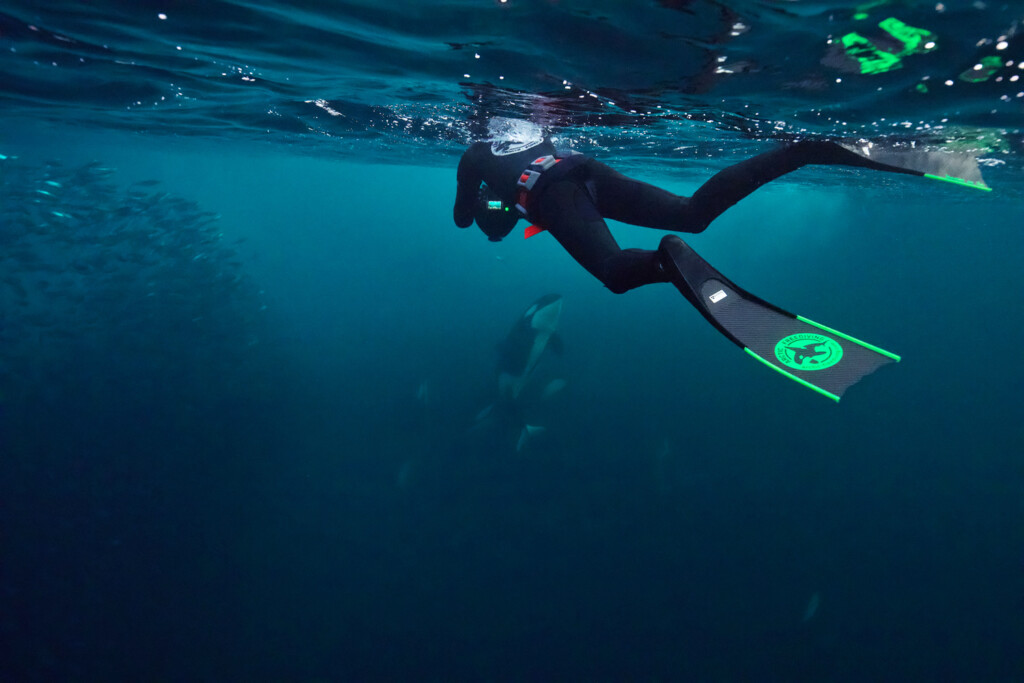
Approach
How much thought and observation goes into the approach phase of an in-water interaction? How much of a briefing is there prior to every single in-water session? If the answer to these questions is almost nothing or zero then it is completely unsafe and unethical.
Just 6 simple rules to remember (and this does not even begin to delve into the topic of approach):
- Cetaceans do not like being approached head-on or directly from the back (either by boat or in-water). For the most part they do not like anything heading straight towards them from any side…
. - Chasing ahead of cetaceans which are clearly moving/ underway and dumping clients into the water a short distance in front of them to get a quick look is unethical and unsafe. It is stressful to the animals (who 9 times out of 10 will just dive down anyway) and can also lead to them abandoning whatever they were busy with / heading towards (food source).
. - If the cetacens(s) you are observing is making deliberate turns away from you, it is time to leave.
. - Approaching any marine life as a line formation or group will most likely result in them leaving the area. Even 20 orcas will use caution and move away when they see 8 people splashing and kicking towards them. One more reason why small groups is a must.
. - Is there already another boat following the same pod? Then it is time to leave. Animals should always feel like they have several options to turn away, which becomes less likely when they have multiple vessels following them from several sides.
. - Did the guide give a clear briefing immediately before entering the water on the plan for the current situation (buddy pairs, approach plan, clear instructions, limitations, safety concerns, collection plan, time limit etc)? If not, DO NOT ENTER THE WATER.
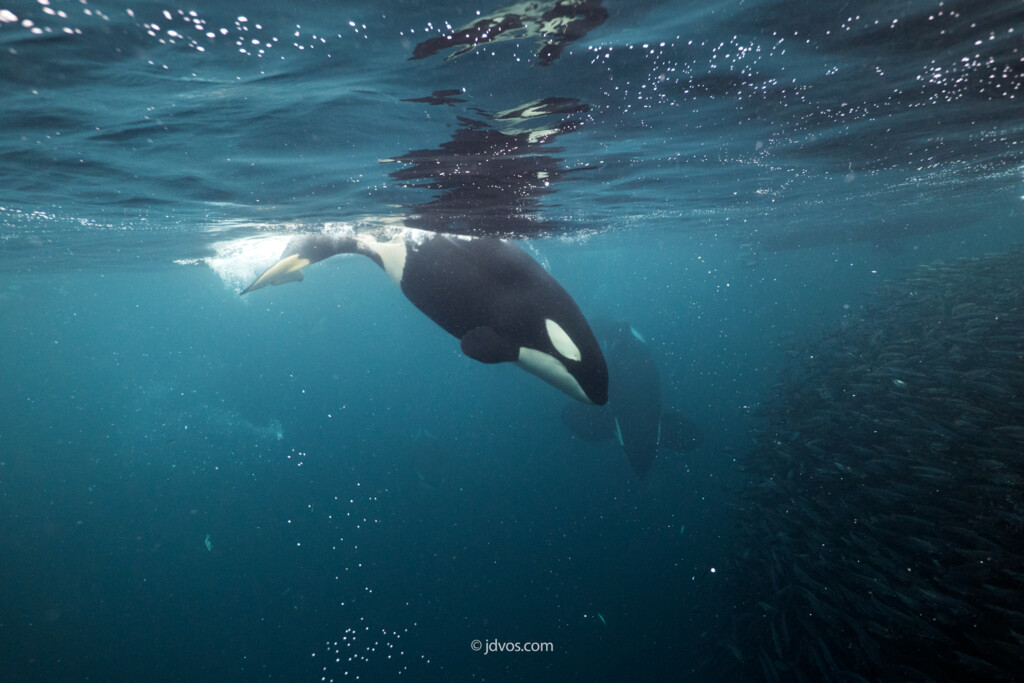
In-Water
Again – just a very brief list of simple rules and points to look out for and follow:
- Never enter the water unsupervised
. - Be sure you are visible (especially to boat traffic and your topside supervision).
. - Always stay with a buddy. If you find yourself completely isolated, it is time to get back to your group or out of the water as quickly as possible.
. - Do not ever attempt to touch a cetacean.
. - Respect distances to animals, people boats and activity as set by your guide / crew or by local regulations and guidelines
. - If you see anything out of place or witness unsafe or unethical behavior, notify the crew immediately and get out.
Fin whales are being seen more often during the season – the second largest animal on earth.
Carousel Feeding Events (Baitballs)
With orcas performing devastating tail slaps while humpback whales appears from below at break neck speeds, surging towards the surface with open mouths in a blink of an eye (we have witnessed as many as 9 at a time!), this is also one of the situations which poses the biggest threat to in-water users if not properly briefed or following proper guidelines.
An example of one of the most shocking social media posts we saw this last winter was from a tourist as a ‘thank you’ to an operator. It was a series of photos from inside a school of herring, including one of an orca emerging from a wall of during a carousel feeding event with a caption along the lines of:
“dropped into the middle of a baitball and enjoyed a herring massage as orcas fed all around me 💕”
For anyone who has any experience with carousel feeding, this description should turn your blood to ice. If you are at the surface and literally getting ‘massaged’ by herring and entirely surrounded by them, you are in one of the most dangerous positions possible. Clearly the person who wrote this knew no better and had no idea how dangerous the situation was that she was in, but for the operator to have allowed this is inexcusable.
To cover all the do’s and don’t’s of carousel feeding is a presentation in itself (which we do cover with all guests), but these are the most basic rules to follow:
- NEVER place yourself on top of or anywhere inside of a baitball. You should always be on the outside (easy to see as it represents the sides of a ball or wall). If you see herring all around you, you are in a very unsafe position.
. - If the baitball moves around you (and it can happen), swim towards the outside as quickly as you can. Here your guide should have the experience and control to direct you.
. - Do not touch or play with any stunned herring
. - Do not swim directly at any animal which is feeding (they will leave the food)
. - Keep a reasonable distance from the baitball as not to disturb it. People can disrupt the shape of the ball and cause the orcas to abandon it
. - If you see one or more humpback whales in the general area (even if it is 50 meters away), notify the others in your group and keep your distance from the ball. Odds are high that the next time you see them will be when they are ‘breach feeding’ through the ball in the blink of an eye.
. - Respect time limits. It might be one of the greatest events in the natural world, but you have no right to spend an hour disrupting it with your presence.

Summary
There are so many facets to running an ethical and safe operation and preparing guests in order to have the best possible experience. That being said, it all starts with getting individuals with the right mindset and attitude as guests and preparing them for what they are going to encounter.
The current challenges being faced by the cetaceans in Northern Norway as well as the whale watching operators who are striving to run ethical operations can be largely eliminated by proper and fair regulations, but also by the actions and informed decisions of clients.
So in closing – if you are planning on joining a whale watching expedition in Northern Norway, please do your research first and once there, do your best to at the very minimum stand up for what you believe is right and more importantly is in the interest of the animals we are fortunate to encounter.
Author information
Jacques de Vos has over 15 years of experience as an In-water Wildlife Guide, Freediving Instructor Trainer, Scuba Instructor and Commercial Diver. He has also played an active role in various conversation and research projects (Norway, Spain and South Africa).
As the founder of Arctic Freediving, Jacques along with his partners at Boreal Yachting were one of the first operators in Norway to offer in-water experiences with orcas, and since Arctic Freediving’s inception, being the first to set mandatory minimum requirements (performance, physical and educational) for guests to join.

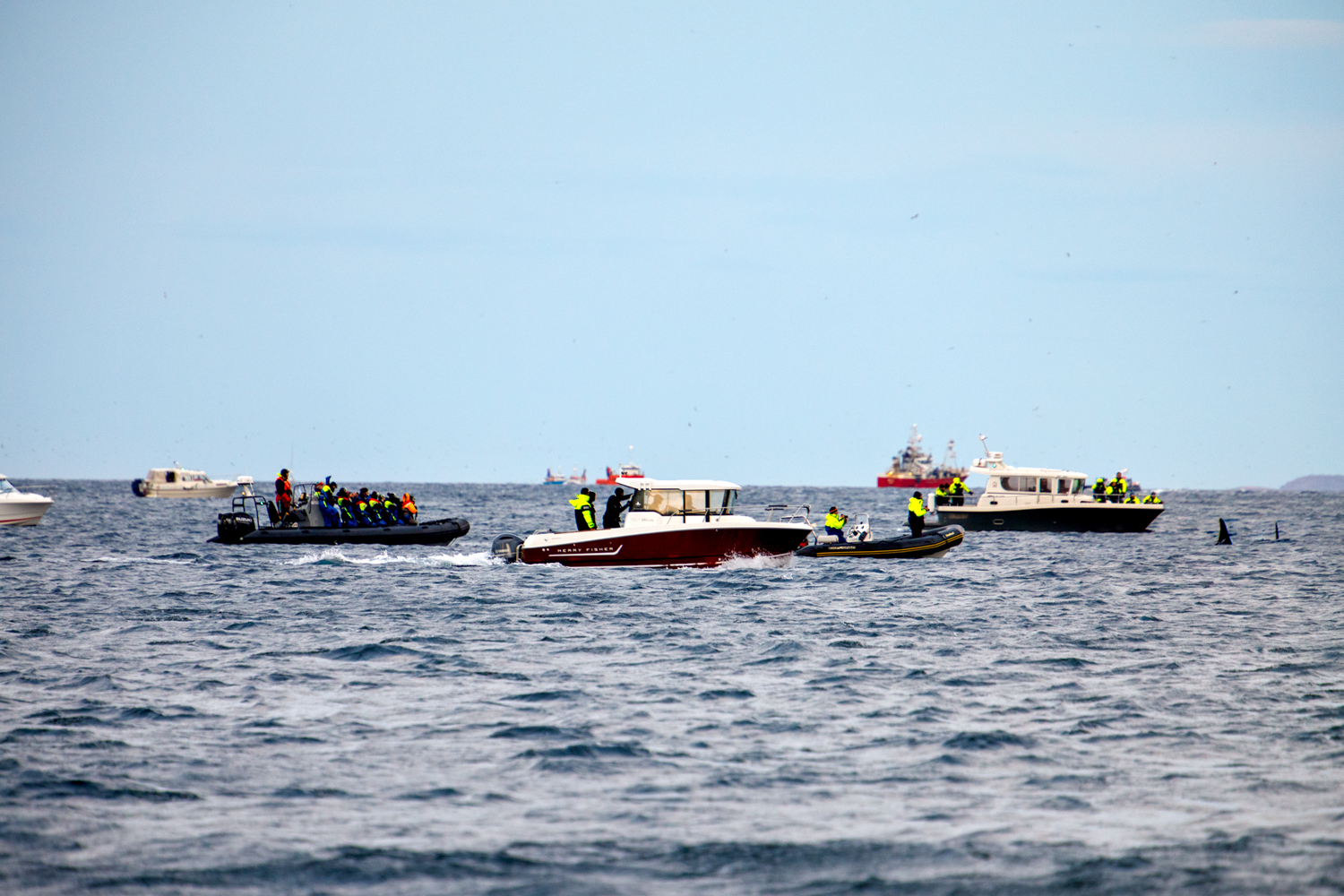

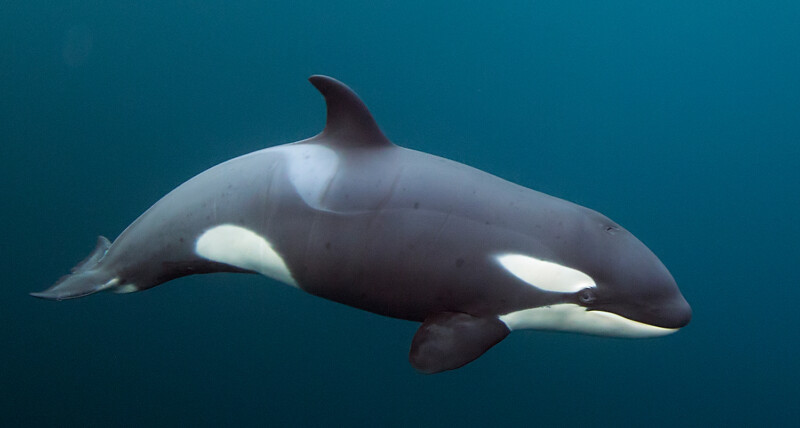
1 Comments
Comments are closed.